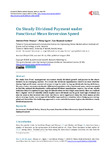| dc.contributor.author | Mtunya, Adeline Peter | |
| dc.contributor.author | Ngare, Philip | |
| dc.contributor.author | Nkansah-Gyekye, Yaw | |
| dc.date.accessioned | 2019-05-07T09:52:24Z | |
| dc.date.available | 2019-05-07T09:52:24Z | |
| dc.date.issued | 2016 | |
| dc.identifier.uri | http://ir.mksu.ac.ke/handle/123456780/4378 | |
| dc.description.abstract | We study how firms’ management can ensure steady dividend growth and payout to the shareholders in an emerging market. We create the dividend equalization reserve account whereby
during high profit some amount of money is kept in order to top up dividends during deficiency.
We use a mean reversion stochastic differential equation with a functional mean reversion speed
to find the optimal dividend policy with optimal dividend equalization reserve. One of our results
indicates that, it is optimal to pay high dividends when we have high mean levels. Also, we realized
that a higher level of volatility which implies more dividend can be paid. And high dividend can
also be paid as the interest rate rises but this is more significant when the firm makes profits
above average. Lastly, we compared the buffer approach to a situation where hedging was not applied and found that the buffering approach is more suitable because it gives shareholders steady
dividend payments. | en_US |
| dc.language.iso | en_US | en_US |
| dc.publisher | Scientific Research Publishing Inc | en_US |
| dc.subject | Investment | en_US |
| dc.subject | Dividend Policy | en_US |
| dc.subject | Steady Payment | en_US |
| dc.subject | Functional Mean Reversion Speed | en_US |
| dc.subject | Stochastic Optimal Control | en_US |
| dc.title | On Steady Dividend Payment under Functional Mean Reversion Speed | en_US |
| dc.type | Article | en_US |

